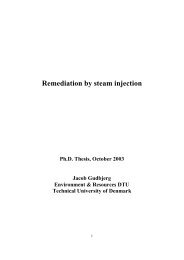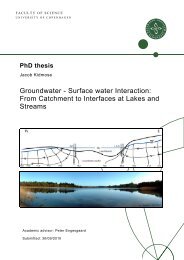Groundwater arsenic in the Red River delta, Vietnam ... - Fiva
Groundwater arsenic in the Red River delta, Vietnam ... - Fiva
Groundwater arsenic in the Red River delta, Vietnam ... - Fiva
You also want an ePaper? Increase the reach of your titles
YUMPU automatically turns print PDFs into web optimized ePapers that Google loves.
In short, <strong>the</strong>re is a consensus among researchers that<br />
<strong>the</strong> As is released from <strong>the</strong> sediment <strong>in</strong>to <strong>the</strong> groundwater.<br />
All major rivers dra<strong>in</strong><strong>in</strong>g <strong>the</strong> Himalayas <strong>in</strong> SE Asia<br />
seem to carry sediment conta<strong>in</strong><strong>in</strong>g As, but not <strong>in</strong> very<br />
high concentration (Smedley and K<strong>in</strong>niburgh, 2002; Stanger,<br />
2005). However, after sedimentation <strong>in</strong> flood pla<strong>in</strong>s<br />
and <strong>delta</strong>’s, <strong>the</strong> As may become released to <strong>the</strong> groundwater.<br />
Typically, <strong>the</strong> Holocene aquifers are anoxic systems<br />
dom<strong>in</strong>ated by organic carbon degradation coupled<br />
to ma<strong>in</strong>ly Fe-oxide reduction and methanogenesis. Once<br />
Fe-oxide reduction starts <strong>in</strong> <strong>the</strong> aquifer, As is ei<strong>the</strong>r desorbed<br />
from <strong>the</strong> surface of <strong>the</strong> dissolv<strong>in</strong>g Fe-oxide or it is<br />
released from <strong>the</strong> m<strong>in</strong>eral structure itself (Nickson et al.,<br />
1998, 2000; McArthur et al., 2001; Dowl<strong>in</strong>g et al., 2002;<br />
Harvey et al., 2002; Swartz et al., 2004). O<strong>the</strong>rs have proposed<br />
that As is mobilized by displacement from sediment<br />
surfaces by HCO 3 generated through <strong>the</strong><br />
dissolution of carbonate and <strong>the</strong> reduction of Fe-oxides<br />
(Appelo et al., 2002; Anawar et al., 2004), although this<br />
mobilization mechanism has been disputed (Radu et al.,<br />
2005). Also, Polizzotto et al. (2006) suggested that As<br />
is not mobilized with<strong>in</strong> <strong>the</strong> aquifer but ra<strong>the</strong>r <strong>in</strong> surface<br />
soil layers and is subsequently transported down through<br />
<strong>the</strong> sandy aquifer.<br />
One of <strong>the</strong> problems encountered <strong>in</strong> <strong>the</strong> Bangladesh and<br />
W. Bengal studies is <strong>the</strong> extreme variability <strong>in</strong> <strong>the</strong> groundwater<br />
As content between boreholes only a 100 m apart<br />
(van Geen et al., 2003; McArthur et al., 2004). Ano<strong>the</strong>r<br />
problem is <strong>the</strong> highly complex hydrology of <strong>the</strong>se floodpla<strong>in</strong><br />
aquifers which conta<strong>in</strong> paddy rice fields, dug ponds,<br />
irrigation channels and <strong>in</strong>tensified groundwater pump<strong>in</strong>g<br />
for irrigation (Harvey et al., 2006). As already suggested<br />
by van Geen et al. (2006) small scale process studies are required<br />
to elucidate <strong>the</strong> processes controll<strong>in</strong>g <strong>the</strong> As release<br />
from <strong>the</strong> sediment to <strong>the</strong> groundwater.<br />
This paper reports <strong>the</strong> results of a detailed study at a<br />
small scale on <strong>the</strong> banks of <strong>the</strong> <strong>Red</strong> <strong>River</strong> 30 km upstream<br />
of Hanoi, <strong>Vietnam</strong>. The field site is situated between <strong>the</strong><br />
ma<strong>in</strong> dyke and <strong>the</strong> river, <strong>the</strong> sediments are <strong>the</strong>refore very<br />
young, and also <strong>the</strong> hydraulic complexities caused by human<br />
activity as mentioned above are avoided <strong>in</strong> this sett<strong>in</strong>g.<br />
The objective of <strong>the</strong> present work is to elucidate <strong>the</strong> geochemical<br />
processes controll<strong>in</strong>g <strong>the</strong> release of As from <strong>the</strong><br />
sediment and <strong>in</strong>to <strong>the</strong> groundwater under more or less prist<strong>in</strong>e<br />
conditions. Reactive transport model<strong>in</strong>g is used to<br />
quantify <strong>the</strong> processes and to identify <strong>the</strong> controll<strong>in</strong>g<br />
parameters for As release to <strong>the</strong> groundwater.<br />
2.1. Well construction<br />
2. METHODS<br />
Wells with a depth rang<strong>in</strong>g from 5-23 m were constructed<br />
us<strong>in</strong>g water-jet drill<strong>in</strong>g, and equipped with<br />
Ø60 mm PVC-cas<strong>in</strong>gs, a 0.3 m long screen and 1 m sand<br />
trap. The water used for jet drill<strong>in</strong>g was pumped from nearby<br />
boreholes or <strong>the</strong> river. A quartz sand filter pack was <strong>in</strong>stalled,<br />
and <strong>the</strong> well was uppermost sealed us<strong>in</strong>g bentonite.<br />
At <strong>the</strong> surface a concrete pad (0.5 m · 0.5 m) with a protective<br />
steel cas<strong>in</strong>g and steel screw cap was constructed. The<br />
Arsenic <strong>in</strong> groundwater of <strong>Vietnam</strong> 5055<br />
top end of <strong>the</strong> PVC-cas<strong>in</strong>g was sealed to prevent <strong>the</strong> entrance<br />
of surface water dur<strong>in</strong>g flood<strong>in</strong>g. Directly after completion<br />
<strong>the</strong> well was pumped to remove <strong>the</strong> water affected<br />
by <strong>the</strong> drill<strong>in</strong>g operation. Then <strong>the</strong> well was left at rest<br />
for at least three months before sampl<strong>in</strong>g.<br />
2.2. Field procedures for sampl<strong>in</strong>g and analysis of<br />
groundwater<br />
<strong>Groundwater</strong> was sampled from <strong>the</strong> boreholes us<strong>in</strong>g a<br />
downhole pump, a Grundfos MP1 or a Whale pump. Five<br />
borehole volumes were flushed before tak<strong>in</strong>g <strong>the</strong> sample. A<br />
flow cell equipped with probes for O 2, pH, and electrical<br />
conductivity (EC) was mounted directly on <strong>the</strong> sampl<strong>in</strong>g<br />
tube. Dur<strong>in</strong>g flush<strong>in</strong>g, <strong>the</strong> EC and pH were determ<strong>in</strong>ed<br />
after each emptied borehole volume to ensure that stable<br />
values were obta<strong>in</strong>ed. The measurements were carried out<br />
with a WTW Multi197i multi-purpose <strong>in</strong>strument us<strong>in</strong>g a<br />
WTW Tetracon 96 EC probe, a WTW SenTix 41 pH electrode<br />
and for dissolved O2 a WTW EO 196-1,5 electrode.<br />
Samples for CH 4 were <strong>in</strong>jected directly from <strong>the</strong> sampl<strong>in</strong>g<br />
tube through a butyl rubber stopper <strong>in</strong>to a pre-weighed<br />
evacuated glass vial, leav<strong>in</strong>g a headspace of one-half to<br />
two-thirds of <strong>the</strong> total volume. After sampl<strong>in</strong>g, <strong>the</strong> vial<br />
was immediately frozen, us<strong>in</strong>g dry ice, <strong>in</strong> an upside down<br />
position <strong>the</strong>reby trapp<strong>in</strong>g <strong>the</strong> gas phase above <strong>the</strong> frozen<br />
water. Samples for all o<strong>the</strong>r parameters were collected <strong>in</strong><br />
50 mL syr<strong>in</strong>ges and filtered through 0.2 lm Sartorius M<strong>in</strong>isart<br />
cellulose acetate filters.<br />
Aqueous As(V) and As(III) were separated by filter<strong>in</strong>g<br />
<strong>the</strong> water sample through first a 0.2 lm membrane filter<br />
and <strong>the</strong>n a disposable anion exchange cartridge at a flow<br />
rate of approximately 6 mL/m<strong>in</strong> us<strong>in</strong>g a syr<strong>in</strong>ge. The anion<br />
exchange cartridge was mounted directly on <strong>the</strong> filter and<br />
<strong>the</strong> comb<strong>in</strong>ation was carefully flushed by N2 before use.<br />
The cartridges conta<strong>in</strong>ed 0.8 g alum<strong>in</strong>osilicate adsorbent<br />
that selectively adsorbs As(V) but not As(III) (Meng and<br />
Wang, 1998). Arsenite was determ<strong>in</strong>ed as <strong>the</strong> As concentration<br />
<strong>in</strong> <strong>the</strong> water filtered through a cartridge, and As(V) was<br />
calculated as <strong>the</strong> difference between <strong>the</strong> total As and As(III)<br />
concentrations.<br />
Ferrous iron, phosphate and sulfide concentrations were<br />
measured spectro-photometrically <strong>in</strong> <strong>the</strong> field us<strong>in</strong>g a Hach<br />
DR/2010 <strong>in</strong>strument. Ferrous iron was measured by <strong>the</strong><br />
Ferroz<strong>in</strong>e method (Stookey, 1970), phosphate us<strong>in</strong>g <strong>the</strong><br />
molybdate blue method and sulfide with <strong>the</strong> methylene blue<br />
method (Cl<strong>in</strong>e, 1967) and <strong>the</strong> detection limits were 1.8, 1.1,<br />
and 0.5 lM, respectively.<br />
Alkal<strong>in</strong>ity was determ<strong>in</strong>ed shortly after sampl<strong>in</strong>g by <strong>the</strong><br />
Gran-titration method (Stumm and Morgan, 1981). Fifty<br />
milliliter samples for <strong>the</strong> cations: Na + ,Ca 2+ ,Mg 2+ , and<br />
K + were preserved with 2% of a 7 M HNO3 solution and<br />
refrigerated until analysis <strong>in</strong> <strong>the</strong> laboratory. Samples for<br />
NH 4 þ ,Cl , and SO4 2 were collected <strong>in</strong> 20-mL polypropylene<br />
vials and frozen immediately after sampl<strong>in</strong>g.<br />
2.3. Laboratory water analysis procedures<br />
Cations were analyzed by flame atomic absorption<br />
spectrophotometry on a Shimadzu AAS 6800 <strong>in</strong>strument.





